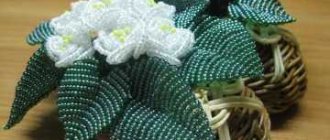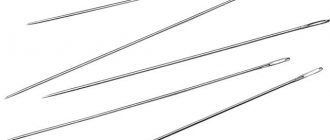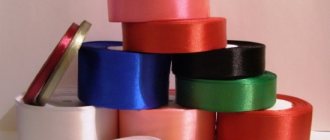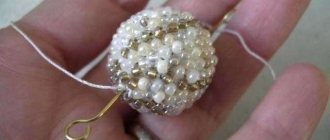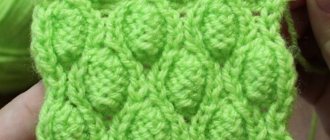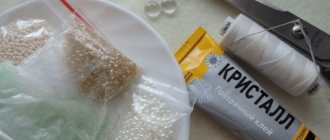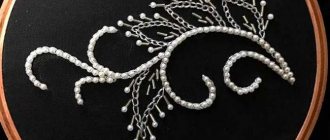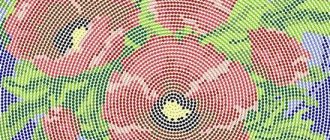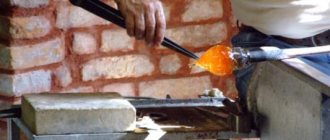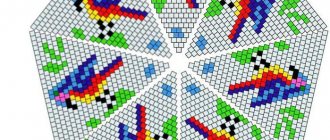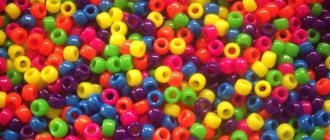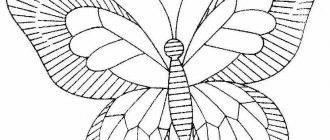Embroidering is easy! Don't believe me? The article reveals the secrets of the correct choice of beads, canvas, threads, needles, and presents a master class on bead embroidery of a bouquet of flowers.
The first specimen of beads known to mankind is kept in the Cairo Museum. In Ancient Egypt, in addition to aesthetic functions, beads played the role of a monetary equivalent and over time conquered the southern part of Europe. Northern Europe at this time preferred embroidery with pearls and amber. Two bead flows could not help but meet, and in the 11th-13th centuries, beads began their world tour, which continues today.
What is the secret of these little beads?
Psychologists have long considered handicrafts to be meditative activities that have a beneficial effect on a person’s general condition:
- brain cells that are tired during the day reduce their activity
- brain cells responsible for creativity and practically not involved in everyday life are activated
- muscles decrease tone
- the nervous system relaxes
- the body reduces oxygen consumption
- blood pressure normalizes
- heartbeat slows down
The general physical and psycho-emotional state of a person resembles the intermediate state of the body between wakefulness and sleep.
And if we take into account that:
- The bead embroidery technique is accessible even to girls of primary school age
- organization of the workplace does not require global changes in the interior
- materials for bead embroidery are varied and available
It is impossible to deny yourself the pleasure of creating a masterpiece with your own hands!
So let's start with the basics.
How to start embroidering with beads correctly? Advice from professionals
1. Clearly decide what exactly you want to embroider: a landscape, a still life with fruits or flowers, an animal picture.
Advice . If this is your first job, start with a small diagram. The maximum size for the first work is 15x15 cm. The color scheme of the first embroidered pattern should be as contrasting as possible.
Important : Working on embroidery with landscapes and still lifes allows you to make some mistakes that are typical for beginners.
2. Decide on the fabric you will embroider on. It should be dense enough to support the weight of the beads and, at the same time, be comfortable to use.
Sovet . It’s better to start on canvas - this base fabric is perfect for counted embroidery techniques.
3. For bead embroidery, special bead needles and threads are used.
General advice . The easiest way to start embroidering is to purchase a ready-made embroidery kit from a specialized store.
The finished set includes:
- a diagram of the future painting and an outline for work. Often, the pattern and outline are replaced by fabric with a printed pattern for full or partial filling with beads
- beads selected in exact accordance with the diagram
- needle for work
- instructions
Please note : embroidery threads are not included in the set! They will need to be purchased separately
Good creativity
Many needlewomen use bead embroidery techniques to create icons. This work is very delicate and painstaking, requiring accuracy and attention.
There are several options for creating an icon:
- when the saint’s vestment is embroidered with beads, and his face is embroidered with satin stitch;
- when the face is applied to the canvas with a finished image, and only the vestments and setting of the icon are embroidered.
If you plan to illuminate a beaded icon in a church, you need to know that work with an embroidered face will most likely be refused. Since this contradicts the Orthodox canons, according to which only monks can paint the faces of saints. Therefore, it is better to choose a set with a face applied to the canvas.
Answer from the clergy about embroidering icons:
The following videos contain recommendations and practical tips for embroidering icons:
First DIY bead embroidery
The quality of the finished work depends not only on the skill of the embroiderer, but also on the quality of the source materials
How to choose good beads for embroidery?
The quality of the beads affects the appearance of the finished work and its durability. If you want to embroider a high-quality product, carefully consider the choice of beads.
Meet the manufacturers
Supplier countries leading in the bead market:
- Japan is the best and most expensive material. Beads withstand temperature, chemical influences, as well as moisture and sunlight. It has a wide through hole, which allows this material to be used not only for embroidery, but also for beading. Taiwanese beads are often sold to inexperienced embroiderers, passing them off as Japanese beads.
- The Czech Republic produces beads , which are inferior in quality to Japanese ones and require a more caring attitude. Quality costs reduce material costs .
- China, as a manufacturer , can offer beads from top-class material to low-quality products.
There are quite a lot of beads from Taiwan, India and Turkey on our markets, but embroiderers have too many complaints about them.
We check the quality
Regardless of what the seller promises and tells you:
1. Be sure to feel the beads you like. Refuse to purchase if there are traces of paint on your fingers.
Important : Beads made from colored material are more expensive than dyed ones.
2. The beads must be calibrated, i.e. selected by size. Pay attention to this when purchasing beads.
The photo below shows the difference in the calibration of Chinese beads. Embroiderers are forced to sort the beads themselves.
If you are unsure of the quality of the beads you are purchasing, purchase a small sample quantity and test the beads at home.
Method 1
- soak the beads in warm soapy water
- Place the wet beads on a light cloth or paper napkins.
If the beads leave colored spots, its quality leaves much to be desired.
Method 2
- Place some of the purchased beads in direct sunlight for 7 days; if the beads are faded, the material is of low quality.
Method 3
- Go over the bead with a nail file.
If the paint is removed from the bead easily and without effort, the embroidery will lose its beauty during the process.
Method 4
- put part of the beads in a small amount of mayonnaise and leave for several days in a dark place.
Look at the changes that have occurred to the beads: if the paint has faded and the beads have lost their shine, do not buy them.
Determining the size
Important : the size of the beads must correspond to the size of the canvas cage, otherwise the embroidery will be deformed.
Beads differ from different manufacturers! The photo below shows the difference in sizing between beads from four different manufacturers. Each string has an equal number of beads - 20 pcs.
- The ratio of the bead number and bead diameter:
No. 21 - 0.8 mm No. 20 - 0.9 mm No. 19 - 1 mm No. 18 - 1.1 mm No. 17 - 1.2 mm No. 16 - 1.3 mm No. 15 - 1.5 mm No. 14 - 1.6 mm No. 13 - 1.7 mm No. 12 - 1.9 mm No. 11 - 2.2 mm No. 10 - 2.3 mm (most often used for embroidery) No. 8 - 3.1 mm No. 6 - 4 mm No. 3 - 5.5 mm No. 1 - 6.5 mm
How to choose a canvas for bead embroidery?
Handicraft stores offer a huge selection of different fabrics. A smart choice for your first embroidered project would be Aida, which is a block fabric. Such fabrics are an excellent basis for counted embroidery.
Properties of Aida canvas
- composition - cotton 100%
- weave squares are clearly visible
- the fabric is rigid, which allows for uniform tension of the embroidery thread
- does not shrink when washed
- well suited for embroidery without a hoop, with a hoop, on a machine
The ratio of the Hades canvas number, the number of cells in 1 inch (2.5 cm), the number of cells in 10 cm.
№6 — 6 — 24 №8 — 8 — 32 №11 — 11 — 44 №14 — 14 — 56 №16 — 16 — 63 №18 — 18 — 71 №20 — 20 — 79 №22 — 22 — 87
Ratio of Aida fabric number to Czech bead number
№6 — №4 №8 — №6 №11 —№8 №14 — №10 №16 — №11 №18 — №12 №20 — №13 №22 — №15
If you prefer another bead, below is an algorithm for selecting a canvas to match the bead number
Algorithm for selecting canvas to bead number
Step 1. Measure the diameter of the selected beads. For example, the diameter of one of your beads is 2.3 mm Step 2. Count the number of beads in 10 cm (100 mm) of fabric 100 mm/2.3 mm = 43.46 beads or 44 whole beads Step 3. When embroidering, the beads are placed at an angle and sewn on edge. In order to determine the number of beads, taking into account the above, multiply the resulting number of beads by the coefficient k = 1.25: 44 beads * 1.25 = 55 beads Conclusion: for your beads you will need fabric with 55 cells per 10 cm Step 4. B table of the ratios of tissue number and number of cells, find the fabric you need
Special needles for bead embroidery: tips for choosing
The video “Bead embroidery for beginners - needles and threads” will tell you in detail how to make the right choice.
Embroidery techniques
embroider an icon using any technique - satin stitch, cross stitch, beads, gold and silver threads. The most difficult thing to master is the technique of sewing on beads. The beads should lie equally evenly and be located in the same direction. To get an even row, you need to insert the needle into the upper right corner of the cage, then string the beads and then make a puncture in the lower left corner. To avoid mistakes, it is recommended to always keep the hoop in one position without turning it over.
There are two techniques for sewing beads:
- Sew on individually , making a puncture after each bead. It takes more time, but the work will be durable. Only the first and last bead are stitched twice.
- Cast on a whole row at once , then go back and attach beads or one at a time.
You can create icons from the center. In this case, the beads are arranged in a spiral. Another method is called chaotic - the workpiece is embroidered in pieces: first the main lines and sections of the same color, then the secondary ones.
Embroidery of a blooming blue bouquet with beads step by step
Scheme of work:
1. Prepare a canvas. The canvas size is calculated in the following way
Based on previous calculations, we have Czech beads No. 10. For embroidery we need Aida canvas No. 14
a) our scheme takes
- 124 cells horizontally
- 190 cells vertically
b) 1 square = 1 bead
c) 55 beads in 10 cm of canvas
Horizontal fabric size:
- 124/55*10cm = 22.5 cm
- Be sure to take into account allowances of 5 cm on both sides
- Total, horizontal canvas size 22.5 cm + 5 cm + 5 cm = 32.5 cm
Vertical fabric size:
- 90/55*10 cm = 16.3 cm
- Allowances on both sides are 5 cm
- Total, vertical canvas size 16.3 cm + 5 cm + 5 cm = 26.3 cm
2. Be sure to sew a blanket stitch around the perimeter of the fabric or apply a thin layer of PVA glue to the edge of the cut and let it dry. This treatment will prevent the canvas threads from spilling out during operation.
3. Many craftswomen mark the fabric with a colored pencil, a special fabric marker or thread. The fabric is marked into 10x10 squares, which corresponds to the layout of the diagram. This method allows you to avoid mistakes when embroidering.
4. Prepare Czech beads No. 10 according to the color scheme shown below.
color 1 - dark blue color 2 - violet with a blue tint color 3 - sea wave color 4 - inky color 5 - green color 6 - light blue color 7 - yellow
Bead shape: round The beads are matte, not transparent.
5. It is convenient to scatter beads for work into special boxes with cells. Plastic containers for freezing ice cubes work well for this purpose.
Be sure to write down the number or color symbol on the diagram for yourself.
6. Prepare embroidery thread, needle, scissors. For bead embroidery, tapestry hoops are often used, securing the canvas to them with pins.
7. By comparing the squares of the diagram and the squares on the canvas, determine the lower right corner of the work (do not forget about the allowances!).
8. Insert the thread into the needle and tie a knot. Secure the knot on the wrong side of the work in the lower right corner. Make one stitch without beads. Next, embroider in horizontal rows from right to left using a monastery stitch. The seam diagram is attached.
Important : the inclination of the beads must be the same! In embroidery, small constrictions of the thread are allowed along the wrong side in places where beads are missing.
The video “Errors in bead embroidery techniques - Golden Handles” will help you avoid common mistakes made by beginners. The video “Bead embroidery for beginners” will introduce you to the basic techniques of embroidery using a finished pattern.
9. Gradually transfer the drawing to the canvas
10. How to beautifully design bead embroidery?
The baguette and mat for embroidery are chosen in accordance with the color scheme of the design. There is no one general recipe here. Sometimes the frame emphasizes the main accents in the color scheme of the embroidery, sometimes it highlights the halftones. It all depends on the general mood of the picture. A specialist in a framing workshop will definitely help you make the right choice.
Embroider on clothes
Bead embroidery is not only a decorative, but also an applied art. With its help, you can turn an ordinary mass-produced item into an exclusive designer outfit.
To embroider with beads according to a pattern on clothing, you will need already familiar materials - beads, threads, scissors. You will also need water-soluble canvas, which will make the task much easier.
Designs for embroidering on clothes:
Video for those who want to learn how to decorate clothes with beads:
Having learned to embroider with beads, any needlewoman will create many beautiful paintings for the interior and as a gift to loved ones. And the applied part of this art will allow her to look bright, fashionable and stylish, causing everyone’s admiration.
How to embroider a picture from beads: tips and reviews
Some tips regarding the selection of beads
Plants
It is customary to embroider tree trunks with matte beads without shine. The color is dense and rich. Work on leaves and flowers allows the use of glazed beads.
Building
It is not customary to use transparent beads. Bright matte beads are used to embroider buildings and their elements. Church domes are embroidered with metal-coated beads
Water
The depth of water and the beauty of snow will be conveyed by transparent beads with a painted center
Air
The blue of the sky is perfectly conveyed by translucent beads. And matte translucent beads will make the clouds in the picture extremely realistic
Heavenly bodies
Bright matte beads suit the Sun, Moon, and stars
